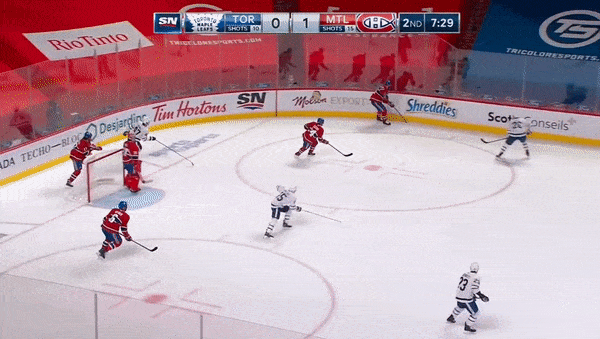The Toronto Maple Leafs visited their closest divisional competitor on Wednesday evening in what was undoubtedly the North Division’s most anticipated matchup to date.
While an early soft goal on Frederik Andersen by Josh Anderson put the Leafs unnecessarily behind the eight-ball, the game very much remained up for grabs until Ilya Mikheyev scored a much-deserved insurance goal early in the third period — a culmination of a Leafs gameplan that stifled the Habs off the rush and limited their quality chances.
While Natural Stat Trick credited the Habs with a determinate edge in Expected Goals For through two periods, the actual unfolding of the game tells a slightly different story in which there were no notable odd-man rushes for Andersen to face.
In this way, defending the blue line was a key part of the Maple Leafs‘ success versus the Habs, and not necessarily for how it was defended by the defensemen. A team effort defensively by the forwards supported the defensemen against quality rush chances.
This is/was done by strong play by the highest forward in the neutral zone who acts as a sort of defensive midfielder: a buffer between the forwards and the defensemen.
Undoubtedly, the most impressive forward in this respect on Wednesday was Ilya Mikheyev. He frequently not only supported a pinching defenseman but also effectively erased a counter-attacking opposition forward, such as in the following example after Muzzin poorly executes a pinch:
This play by Mikheyev is crucial to the Leafs’ defensive success, as they expect any and all of their defensemen to be prepared to pinch. That means one or more forwards play a crucial role in defending the neutral zone (either as F3 or as a defender). The Leafs want to strike a balance between attacking and defending, which means activating defensemen in support of the attack and having forwards deactivate in support of defending the blueline.
In the above play, the Leafs were still down a goal, prompting Muzzin to activate. The ultimate result is a testament to Mikheyev’s skill set of speed, strength, stick, and hockey IQ in the transition game.
In fact, Muzzin should probably take Mikheyev out for a bowl of soup after the support he was given in the game (not one of his best, to say the least) by the Souperman. In the following play a little earlier in the game, another ineffective pinch by Muzzin turns into a highlight-worthy defensive play by Mikheyev, who skates backward, stands his ground, and takes the Canadiens puck carrier out of the play along the boards:
In this game, plays like Mikheyev’s were made aplenty by Leaf forwards, ensuring Leafs defensemen were were not often tasked with defending the blueline in space.
Muzzin was a great beneficiary of an active and conscientious F3 throughout the game. In the example below, Travis Boyd supports the pinch as well as Justin Holl, who on this play shows his acumen for defending in space after (another) failed pinch by Muzzin:
It should be noted that the Montreal Canadiens forwards occasionally let the Leafs off the hook in this game by not attacking the blue line with enough intent. Take the following play, where Nic Petan has identified the situation and positioned himself in the supporting role. Phillip Danault enters the zone and veers away from him towards Muzzin before letting a weak shot go:
In most cases, defending the blueline from a rush attack is a culmination of a turnover, whether it be a failed forecheck or a failed pass in the attacking zone or neutral zone. In the following example, we see a failed forecheck leading to Nic Petan doing an admirable F3 job, Zach Bogosian standing his ground with good movement and a long active stick, while Travis Dermott awkwardly gravitates toward the puck, putting himself in a precarious position when defending the driving Habs winger (Dermott made a similar play later on in the game on a play that was eventually called offside):
Dermott is often credited with excellent gap control, typically around the blueline but also in the neutral zone, where his speed and edges are an asset. In the following play, he finds himself as the last man back defending against a budding counter-attack:
Dermott needs to continue to become reliable in this defensive structure. In his case, it means improving on reading plays and utilizing his unique tools exhibited in the following play after a turnover by Jimmy Vesey. Dermott closes out the attacking Habs forward along the boards, using a strong stick, positioning, and speed to force a dump-in:
In the next play, Morgan Rielly uses his superior speed and edges along with an active stick to defend against a counter-attack off of a turnover. Rielly maintains an excellent gap with the puck carrier, smothering the counter-attack:

What can make Rielly such a consistent threat against the counter-attack is his ability to not only read plays but also be firmly situated in them through his speed and edges. On the following play, after a misplaced pass by Brodie, Rielly uses an active stick and recovery skating speed to hold a high defensive line:
Recovering the puck at or near the attacking blueline is far preferable to defending the blueline from a rush attack or a dump-in. On the following play following a failed forecheck, both Rielly and Brodie nevertheless effectively defend in space using their speed, positioning, and active sticks, with support from Mitch Marner:
A perfect example of how the best way to defend the blueline: Forward pressure stifling a counter-attack in the neutral zone, as demonstrated in the following play by Jason Spezza, supported by Jake Muzzin, with the Leafs nursing a two-goal lead:
In contrast, we can see how too much space between the forwards and defensemen can cause havoc in defending the blueline from a rush attack, whether it involves the defenders sitting too deep or the forwards applying ineffective pressure on the puck:
Upon review, from the point of view of defending the blue line, the Leafs in fact played an excellent team game, especially defensively, regardless of what the shot clock and Expected Goals For metrics suggest.
Leafs defenders hardly had to defend against the rush, as the team as a whole was effectively recovering pucks and defending against the Habs generating speed through the neutral zone. On the occasions when it did happen after a misplaced pass or failed forecheck, Leafs defenders were able to use their speed and sticks, with the help of an F3, to successfully defend.
Take for example this last clip, where we see a tremendous effort by Matthews through the neutral zone, strong positioning from Holl, and finally a puck retrieval by Matthews:
It goes without saying that defensive success requires a team effort at all ends of the ice. The new personnel on defense has helped unlock the ability of the team as a whole to play a strong two-way game. Moreover, the Leafs’ coaching staff is implementing a gameplan that takes advantage of the two-way tools exhibited by key players throughout the lineup, such as the underrated Ilya Mikheyev.


![Sheldon Keefe Post Game, Leafs 3 vs. Bruins 2: “I loved [the Matthews] line, and I loved a lot about our game all the way through the lineup” Sheldon Keefe, Toronto Maple Leafs post game](https://mapleleafshotstove.com/wp-content/uploads/2024/04/keefe-pg-game-1-218x150.jpg)


![Jim Montgomery on adjustments for Game 2 vs. the Maple Leafs: “We need to spend more time in the offensive zone… We didn’t do a good job offensively at five-on-five [in Game 1]” Jim Montgomery, Boston Bruins practice](https://mapleleafshotstove.com/wp-content/uploads/2024/04/jim-montgomery-bruins-218x150.jpg)

































![Sheldon Keefe Post Game, Leafs 3 vs. Bruins 2: “I loved [the Matthews] line, and I loved a lot about our game all the way through the lineup” Sheldon Keefe, Toronto Maple Leafs post game](https://mapleleafshotstove.com/wp-content/uploads/2024/04/keefe-pg-game-1-100x70.jpg)




![Jim Montgomery on adjustments for Game 2 vs. the Maple Leafs: “We need to spend more time in the offensive zone… We didn’t do a good job offensively at five-on-five [in Game 1]” Jim Montgomery, Boston Bruins practice](https://mapleleafshotstove.com/wp-content/uploads/2024/04/jim-montgomery-bruins-100x70.jpg)


